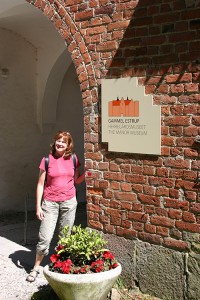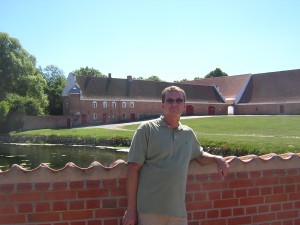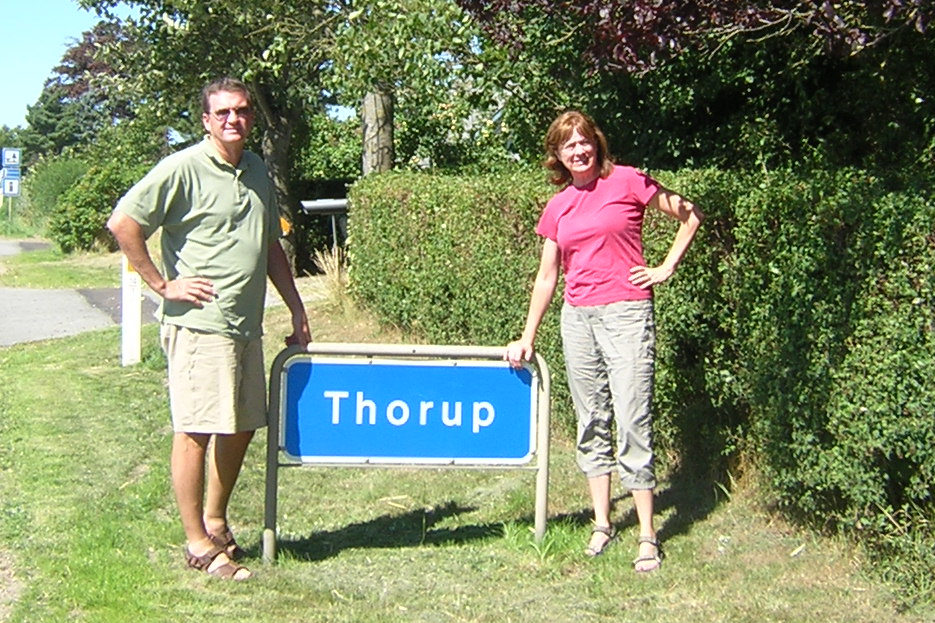Twice I visited Denmark. Both times I tried to find Thorup with no luck. My conclusion is that Thorup was swallowed by the expansion of Randers.
Neils Mikkelsen was from Thorup. (Randers?) Unfortunately, I didn’t do enough research before my first two visits. I’ll prepare better before my next visit. From what I’ve read he grew up within a few miles from Randers. The city is much bigger now.

On our 2nd visit to Denmark we visited Gammel Estrup which is near Randers. What is cool about Gammel Estrup is that I think Neils Mikkelsen worked there while he was a young man. I heard that he worked with the horses and I have a picture of him in a military uniform on a horse. At Gammel Estrup?
Gammel Estrup is the focal point of the Viborg and Randers area. Niels, at a minimum, would have visited there. What’s cool is that the manor is now a museum and restored. If you get a chance it is worth a visit.
Gammel Estrup Manor (
Danish: Gammel Estrup) is a red-brick
Renaissance manor house some 20 km (12 mi) east of
Randers in
Jutland, Denmark. The manor as we know it today can be traced back to 1490. But excavations have revealed evidence of earlier constructions also mentioned in texts under the name
Essendrup dating back to 1340.
[1][2]
History[edit]
The construction of Gammel Estrup was started around 1490 by the contentious
Lave Brock who built a moated fortress on the site.
[3] But it was his great-grandson,
Eske Brock (1560-1625) who rebuilt and modernized the manor. Eske Brock was a nobleman and close friend of King
Christian IV to whom he also served as a minister. Through Brock’s detailed diaries we know a great deal about how a rich nobleman lived at that time. The Brock family, who owned the manor until 1625, also had a number of other estates in the area.
[4] The building then passed into the hands of the equally rich Skeel family who maintained ownership until 1926.
[1]
Since 1930 the manor has been a museum, showing the development of Danish nobility through the ages. The rooms are furnished as they might have been in past centuries. There is also an exhibition depicting the conditions under which the servants and household staff used to live.
[5]
The surrounding buildings support the museum, the nearby apple plantation and a horticulture research center.
The museum is open from 10 a.m. to 5 p.m. every day from mid-April to mid-October and on most days the rest of the year except January when it is closed.
[6]
References[ edit]
edit]
 On our 2nd visit to Denmark we visited Gammel Estrup which is near Randers. What is cool about Gammel Estrup is that I think Neils Mikkelsen worked there while he was a young man. I heard that he worked with the horses and I have a picture of him in a military uniform on a horse. At Gammel Estrup?
Gammel Estrup is the focal point of the Viborg and Randers area. Niels, at a minimum, would have visited there. What’s cool is that the manor is now a museum and restored. If you get a chance it is worth a visit.
Gammel Estrup Manor (Danish: Gammel Estrup) is a red-brick Renaissance manor house some 20 km (12 mi) east of Randers in Jutland, Denmark. The manor as we know it today can be traced back to 1490. But excavations have revealed evidence of earlier constructions also mentioned in texts under the nameEssendrup dating back to 1340.[1][2]
On our 2nd visit to Denmark we visited Gammel Estrup which is near Randers. What is cool about Gammel Estrup is that I think Neils Mikkelsen worked there while he was a young man. I heard that he worked with the horses and I have a picture of him in a military uniform on a horse. At Gammel Estrup?
Gammel Estrup is the focal point of the Viborg and Randers area. Niels, at a minimum, would have visited there. What’s cool is that the manor is now a museum and restored. If you get a chance it is worth a visit.
Gammel Estrup Manor (Danish: Gammel Estrup) is a red-brick Renaissance manor house some 20 km (12 mi) east of Randers in Jutland, Denmark. The manor as we know it today can be traced back to 1490. But excavations have revealed evidence of earlier constructions also mentioned in texts under the nameEssendrup dating back to 1340.[1][2]
 edit]
edit]